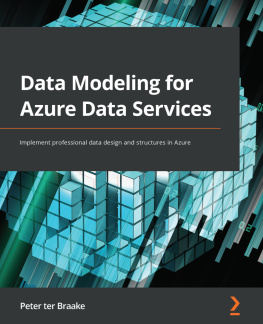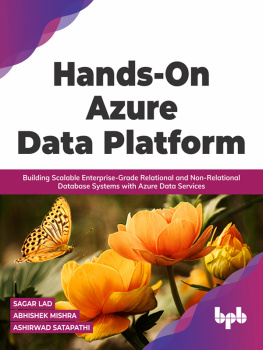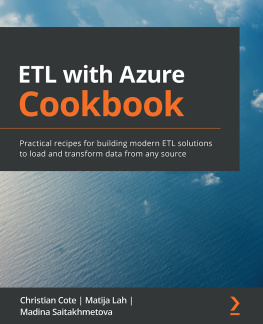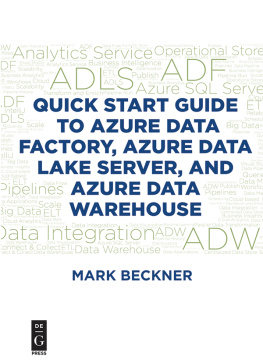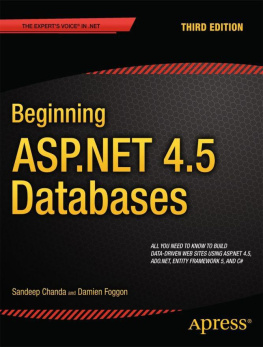Peter ter Braake - Data Modeling for Azure Data Services: Implement professional data design and structures in Azure
Here you can read online Peter ter Braake - Data Modeling for Azure Data Services: Implement professional data design and structures in Azure full text of the book (entire story) in english for free. Download pdf and epub, get meaning, cover and reviews about this ebook. year: 2021, publisher: Packt Publishing, genre: Home and family. Description of the work, (preface) as well as reviews are available. Best literature library LitArk.com created for fans of good reading and offers a wide selection of genres:
Romance novel
Science fiction
Adventure
Detective
Science
History
Home and family
Prose
Art
Politics
Computer
Non-fiction
Religion
Business
Children
Humor
Choose a favorite category and find really read worthwhile books. Enjoy immersion in the world of imagination, feel the emotions of the characters or learn something new for yourself, make an fascinating discovery.
- Book:Data Modeling for Azure Data Services: Implement professional data design and structures in Azure
- Author:
- Publisher:Packt Publishing
- Genre:
- Year:2021
- Rating:3 / 5
- Favourites:Add to favourites
- Your mark:
Data Modeling for Azure Data Services: Implement professional data design and structures in Azure: summary, description and annotation
We offer to read an annotation, description, summary or preface (depends on what the author of the book "Data Modeling for Azure Data Services: Implement professional data design and structures in Azure" wrote himself). If you haven't found the necessary information about the book — write in the comments, we will try to find it.
Choose the right Azure data service and correct model design for successful implementation of your data model with the help of this hands-on guide
Key Features- Design a cost-effective, performant, and scalable database in Azure
- Choose and implement the most suitable design for a database
- Discover how your database can scale with growing data volumes, concurrent users, and query complexity
Data is at the heart of all applications and forms the foundation of modern data-driven businesses. With the multitude of data-related use cases and the availability of different data services, choosing the right service and implementing the right design becomes paramount to successful implementation.
Data Modeling for Azure Data Services starts with an introduction to databases, entity analysis, and normalizing data. The book then shows you how to design a NoSQL database for optimal performance and scalability and covers how to provision and implement Azure SQL DB, Azure Cosmos DB, and Azure Synapse SQL Pool. As you progress through the chapters, youll learn about data analytics, Azure Data Lake, and Azure SQL Data Warehouse and explore dimensional modeling, data vault modeling, along with designing and implementing a Data Lake using Azure Storage. Youll also learn how to implement ETL with Azure Data Factory.
By the end of this book, youll have a solid understanding of which Azure data services are the best fit for your model and how to implement the best design for your solution.
What you will learn- Model relational database using normalization, dimensional, or Data Vault modeling
- Provision and implement Azure SQL DB and Azure Synapse SQL Pools
- Discover how to model a Data Lake and implement it using Azure Storage
- Model a NoSQL database and provision and implement an Azure Cosmos DB
- Use Azure Data Factory to implement ETL/ELT processes
- Create a star schema model using dimensional modeling
This book is for business intelligence developers and consultants who work on (modern) cloud data warehousing and design and implement databases. Beginner-level knowledge of cloud data management is expected.
Table of Contents- Introduction to Databases
- Entity Analysis
- Normalizing Data
- Provisioning and Implementing an Azure SQL DB
- Design a NoSQL Database
- Provisioning and Implementing an Azure Cosmos DB Database
- Dimensional Modeling
- Provision and implement an Azure Synapse SQL Pool
- Data Vault Modeling
- Designing and Implementing a Data Lake Using Azure Storage
- Implementing ETL Using Azure Data Factory
Peter ter Braake: author's other books
Who wrote Data Modeling for Azure Data Services: Implement professional data design and structures in Azure? Find out the surname, the name of the author of the book and a list of all author's works by series.

